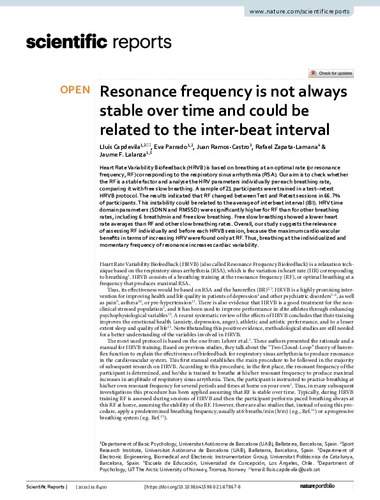Mostra el registre d'ítem simple
Resonance frequency is not always stable over time and could be related to the inter-beat interval
| dc.contributor.author | Capdevila Ortis, Lluís |
| dc.contributor.author | Parrado Romero, Eva |
| dc.contributor.author | Ramos Castro, Juan José |
| dc.contributor.author | Zapata Lamana, Rafael |
| dc.contributor.author | Lalanza, Jaume F. |
| dc.contributor.other | Universitat Politècnica de Catalunya. Departament d'Enginyeria Electrònica |
| dc.date.accessioned | 2022-02-07T11:03:44Z |
| dc.date.available | 2022-02-07T11:03:44Z |
| dc.date.issued | 2021-04-16 |
| dc.identifier.citation | Capdevila, L. [et al.]. Resonance frequency is not always stable over time and could be related to the inter-beat interval. "Scientific reports", 16 Abril 2021, vol. 11, p. 8400:1-8400:11. |
| dc.identifier.issn | 2045-2322 |
| dc.identifier.uri | http://hdl.handle.net/2117/361780 |
| dc.description.abstract | Heart Rate Variability Biofeedback (HRVB) is based on breathing at an optimal rate (or resonance frequency, RF) corresponding to the respiratory sinus arrhythmia (RSA). Our aim is to check whether the RF is a stable factor and analyse the HRV parameters individually per each breathing rate, comparing it with free slow breathing. A sample of 21 participants were trained in a test–retest HRVB protocol. The results indicated that RF changed between Test and Retest sessions in 66.7% of participants. This instability could be related to the average of interbeat interval (IBI). HRV time domain parameters (SDNN and RMSSD) were significantly higher for RF than for other breathing rates, including 6 breath/min and free slow breathing. Free slow breathing showed a lower heart rate averages than RF and other slow breathing rates. Overall, our study suggests the relevance of assessing RF individually and before each HRVB session, because the maximum cardiovascular benefits in terms of increasing HRV were found only at RF. Thus, breathing at the individualized and momentary frequency of resonance increases cardiac variability. |
| dc.description.sponsorship | Tis study was supported by “Ministerio de Ciencia e Innovación” of the Spanish Government (Grant number PID2019-107473RB-C2). |
| dc.language.iso | eng |
| dc.publisher | Nature |
| dc.rights | Attribution 4.0 International |
| dc.rights.uri | https://creativecommons.org/licenses/by/4.0/ |
| dc.subject | Àrees temàtiques de la UPC::Enginyeria electrònica::Instrumentació i mesura |
| dc.subject.lcsh | Electric measurements - Instruments |
| dc.title | Resonance frequency is not always stable over time and could be related to the inter-beat interval |
| dc.type | Article |
| dc.subject.lemac | Electrònica--Mesuraments--Aparells i instruments |
| dc.identifier.doi | 10.1038/s41598-021-87867-8 |
| dc.description.peerreviewed | Peer Reviewed |
| dc.relation.publisherversion | https://www.nature.com/articles/s41598-021-87867-8 |
| dc.rights.access | Open Access |
| local.identifier.drac | 31890907 |
| dc.description.version | Postprint (published version) |
| dc.relation.projectid | info:eu-repo/grantAgreement/AEI/Plan Estatal de Investigación Científica y Técnica y de Innovación 2017-2020/PID2019-107473RB-C22/ES/METODOS NO INTRUSIVOS PARA MONITORIZAR EL PROCESO DE ESFUERZO%2FRECUPERACION BASADOS EN EL ANALISIS DE LA CALIDAD DEL SUEÑO Y LA ESTIMACION DEL BALANCE DE CARGA INTERNA%2FEXTERNA/ |
| local.citation.author | Capdevila, L.; Parrado , E.; Ramos, J.; Zapata, R.; Lalanza, J. |
| local.citation.publicationName | Scientific reports |
| local.citation.volume | 11 |
| local.citation.startingPage | 8400:1 |
| local.citation.endingPage | 8400:11 |
Fitxers d'aquest items
Aquest ítem apareix a les col·leccions següents
-
Articles de revista [1.729]


